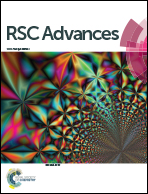A novel method to modify the color of VO2-based thermochromic smart films by solution-processed VO2@SiO2@Au core–shell nanoparticles†
Abstract
In this study, the VO2@SiO2@Au core–shell nanoparticles were synthesized by a solution process to tailor the color of VO2 films on the basis of surface plasmon resonance (SPR). The SiO2 interlayer not only provided more hydroxyl bonding for the silane coupling agent, which was conducive to metal deposition, but also significantly improved the anti-oxidation ability of VO2. We optimized the thickness of silica to maintain the silica layer uniform and thin (14 nm), which would impact on the optical properties. The VO2@SiO2@Au films with various Au particle sizes displayed a series of colors from brick red to purple and blue while maintaining the solar modulation ability (the maximum ΔTsol is up to 7.52%). Moreover, the phase transition temperature decreased by about 6 °C without doping due to electron injection from Au to VO2. This study proposed a novel and facile method to tune the color of VO2-based thermochromic smart films while improving the anti-oxidation ability and decreasing the phase transition temperature. It may constitute a great advance in the development of thermochromic smart films.


 Please wait while we load your content...
Please wait while we load your content...